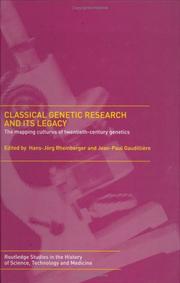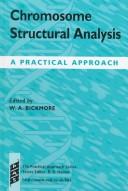| Listing 1 - 10 of 99 | << page >> |
Sort by
|
Book
ISBN: 0323918107 0323972314 9780323918107 9780323972314 Year: 2022 Publisher: London, UK Academic Press
Abstract | Keywords | Export | Availability | Bookmark
 Loading...
Loading...Choose an application
- Reference Manager
- EndNote
- RefWorks (Direct export to RefWorks)
Transcriptome Profiling: Progress and Prospects assists readers in assessing and interpreting a large number of genes, up to and including an entire genome. It provides key insights into the latest tools and techniques used in transcriptomics and its relevant topics which can reveal a global snapshot of the complete RNA component of a cell at a given time. This snapshot, in turn, enables the distinction between different cell types, different disease states, and different time points during development. Transcriptome analysis has been a key area of biological inquiry for decades. The next-generation sequencing technologies have revolutionized transcriptomics by providing opportunities for multidimensional examinations of cellular transcriptomes in which high-throughput expression data are obtained at a single-base resolution. Transcriptome analysis has evolved from the detection of single RNA molecules to large-scale gene expression profiling and genome annotation initiatives. Written by a team of global experts, key topics in Transcriptome Profiling include transcriptome characterization, expression analysis of transcripts, transcriptome and gene regulation, transcriptome profiling and human health, medicinal plants transcriptomics, transcriptomics and genetic engineering, transcriptomics in agriculture, and phylotranscriptomics. Presents recent development in the tools and techniques in transcriptomic characterization Integrates expression analysis of transcripts and gene regulation Includes the application of transcriptomics in human health, genetic engineering and agriculture
Genetic transcription. --- Gene mapping. --- Chromosome mapping --- Genetic mapping --- Genome mapping --- Linkage mapping (Genetics) --- Mapping, Gene --- Genetics --- Transcription (Genetics) --- Genetic code --- Technique --- Chromosome Mapping --- Genome Mapping --- Gene Mapping --- Linkage Mapping --- Chromosome Mappings --- Gene Mappings --- Genome Mappings --- Linkage Mappings --- Mapping, Chromosome --- Mapping, Genome --- Mapping, Linkage --- Mappings, Chromosome --- Mappings, Gene --- Mappings, Genome --- Mappings, Linkage --- Cytogenetics --- Genetic Markers --- Cytogenetic Analysis --- Gene Order --- Synteny --- Transcription, Genetic
Book
ISBN: 9781631171710 1631171712 1631171577 9781631171574 Year: 2014 Publisher: New York
Abstract | Keywords | Export | Availability | Bookmark
 Loading...
Loading...Choose an application
- Reference Manager
- EndNote
- RefWorks (Direct export to RefWorks)
Gene mapping. --- Chromosome mapping --- Genetic mapping --- Genome mapping --- Linkage mapping (Genetics) --- Mapping, Gene --- Genetics --- Technique
Book
Year: 2016 Publisher: Frontiers Media SA
Abstract | Keywords | Export | Availability | Bookmark
 Loading...
Loading...Choose an application
- Reference Manager
- EndNote
- RefWorks (Direct export to RefWorks)
Genome-wide association studies (GWAS) for complex disorders with large case-control populations have been performed on hundreds of traits in more than 1200 published studies (http://www.genome.gov/gwastudies/) but the variants detected by GWAS account for little of the heritability of these traits, leading to an increasing interest in using family based designs. While GWAS studies are designed to find common variants with low to moderate attributable risks, family based studies are expected to find rare variants with high attributable risk. Because family-based designs can better control both genetic and environmental background, this study design is robust to heterogeneity and population stratification. Moreover, in family-based analysis, the background genetic variation can be modeled to control the residual variance which could increase the power to identify disease associated rare variants. Analysis of families can also help us gain knowledge about disease transmission and inheritance patterns. Although a family-based design has the advantage of being robust to false positives, novel and powerful methods to analyze families in genetic epidemiology continue to be needed, especially for the interaction between genetic and environmental factors associated with disease. Moreover, with the rapid development of sequencing technology, advances in approaches to the design and analysis of sequencing data in families are also greatly needed. The 11 articles in this book all introduce new methodology and, using family data, substantial new findings are presented in the areas of infectious diseases, diabetes, eye traits, autism spectrum disorder and prostate cancer.
Regional heritability --- prostate cancer --- infectious diseases --- MCMC --- combining studies screening --- conditional-logistic linkage --- Informatics --- autism
Book
Year: 2022 Publisher: Berlin Universitätsverlag der Technischen Universität Berlin
Abstract | Keywords | Export | Availability | Bookmark
 Loading...
Loading...Choose an application
- Reference Manager
- EndNote
- RefWorks (Direct export to RefWorks)
The availability and accessibility of comprehensive, high-quality data are indispensable prerequisites for effective health services research. It can be assumed in the coming years that health services research will increasingly be based on data linkage, i.e. the linking of several data sources based on suitable common key variables. In Germany, comprehensive high-quality data are routinely collected, but their suitability and availability for research purposes is limited. Therefore, the motivation for this report lies in the answering of two basic questions: which questions of health services research can be better answered abroad on the basis of better data, and in which ways such conditions could be achieved in Germany. Case studies of interesting linkage approaches from twelve countries were identified and analyzed based on a predefined conceptual framework. Information on all comparison countries or case studies was first identified from publicly available sources. Profiles were then created for each country and case study and forwarded to appropriate country experts for validation and completion. The report presents an overview of the included case studies (chapter 3), as well as key information per country and case study in the appendix. This is followed by a closer look at the possibilities of using routine data (chapter 4), linkage approaches with and without unique personal identifiers (chapter 5), the different access routes for researchers (chapter 6), options for using data from electronic patient or health records for research (chapter 7), and an interim conclusion (chapter 8). The report ends with a wish list for possible regulatory changes in light of the current policy debate in Germany (Chapter 9). It is important to underline here that case studies from the international comparison were selected to highlight important aspects that could be relevant to the challenges in Germany. In addition to the added value of comparatively easily accessible, extensive claims data, which are available more quickly than in Germany, allow cross-sector analyses and can be linked to health data and regional data on a person-by-person basis, the potential of databases created on the basis of the routine documentation of service providers (usually electronic health records) is also discussed. Investing in this direction can not only provide insights for a country’s own healthcare system, but also promote international cooperation and contribute to the international visibility of scientific excellence. A juxtaposition of the data sets available in Germany and those used in other countries suggests that the discussion in Germany should focus first and foremost on optimizing the availability and accessibility of existing data and consider new approaches to the collection of additional information as a supplement.
Periodical
Abstract | Keywords | Export | Availability | Bookmark
 Loading...
Loading...Choose an application
- Reference Manager
- EndNote
- RefWorks (Direct export to RefWorks)
Genomics --- Human genetics --- Gene mapping --- Genomes --- Genetique humaine --- Cartes chromosomiques --- Genome --- Chromosome Mapping --- Genetics, Medical --- Genetics --- Genome Mapping --- Gene Mapping --- Linkage Mapping --- Chromosome Mappings --- Gene Mappings --- Genome Mappings --- Linkage Mappings --- Mapping, Chromosome --- Mapping, Gene --- Mapping, Genome --- Mapping, Linkage --- Mappings, Chromosome --- Mappings, Gene --- Mappings, Genome --- Mappings, Linkage --- Human Genetics --- Medical Genetics --- Genetics, Human --- Cytogenetics --- Genetic Markers --- Cytogenetic Analysis --- Gene Order --- Synteny --- Anthropology, Physical --- Chromosome Disorders --- Sex Chromosome Disorders --- Genetic Diseases, Inborn --- Molecular Medicine --- Genes --- Proteome --- Genome. --- Genetics, Medical. --- Chromosome Mapping.

ISBN: 1280525916 9786610525911 0198023529 1429401133 9781429401135 9780195071160 0195071166 9781280525919 0195071166 6610525919 9780198023524 0197700268 Year: 2023 Publisher: New York ; Oxford University Press,
Abstract | Keywords | Export | Availability | Bookmark
 Loading...
Loading...Choose an application
- Reference Manager
- EndNote
- RefWorks (Direct export to RefWorks)
The common fruitfly, or drosophila, is the most extensively studied of all organisms from the standpoint of genetics and cytology. The aim of this reference is to summarize information about most of the drosophila genes for which the complete nucleotide sequence is known.
Drosophila --- Gene mapping --- Chromosome mapping --- Genetic mapping --- Genome mapping --- Linkage mapping (Genetics) --- Mapping, Gene --- Genetics --- Drosophilidae --- Fruit-flies --- Technique

ISBN: 0415860105 128010421X 9786610104215 0203375297 9780203375297 9780415328494 0415328497 0415328497 9781134334155 113433415X 9781134334100 1134334109 9781134334148 1134334141 9780415860109 6610104212 Year: 2004 Publisher: London New York Routledge
Abstract | Keywords | Export | Availability | Bookmark
 Loading...
Loading...Choose an application
- Reference Manager
- EndNote
- RefWorks (Direct export to RefWorks)
With the rise of genomics, the life sciences have entered a new era. This book provides a comprehensive history of mapping procedures as they were developed in classical genetics. An accompanying volume - From Molecular Genetics to Genomics - covers the history of molecular genetics and genomics.The book shows that the technology of genetic mapping is by no means a recent acquisition of molecular genetics or even genetic engineering. It demonstrates that the development of mapping technologies has accompanied the rise of modern genetics from its very beginnings. In Section One
Gene mapping --- Chromosome mapping --- Genetic mapping --- Genome mapping --- Linkage mapping (Genetics) --- Mapping, Gene --- Genetics --- History --- Technique --- Genetic research
Book
ISBN: 1587292483 9781587292484 0877454558 0877454566 9780877454557 9780877454564 Year: 1994 Publisher: Iowa City : University of Iowa Press,
Abstract | Keywords | Export | Availability | Bookmark
 Loading...
Loading...Choose an application
- Reference Manager
- EndNote
- RefWorks (Direct export to RefWorks)
Human genetics --- Human gene mapping --- Chromosome Mapping. --- Genome, Human. --- Ethics, Medical. --- Medical Ethics --- Medicine --- Professionalism --- Bioethics --- Human Genome --- Genomes, Human --- Human Genomes --- Genome Mapping --- Gene Mapping --- Linkage Mapping --- Chromosome Mappings --- Gene Mappings --- Genome Mappings --- Linkage Mappings --- Mapping, Chromosome --- Mapping, Gene --- Mapping, Genome --- Mapping, Linkage --- Mappings, Chromosome --- Mappings, Gene --- Mappings, Genome --- Mappings, Linkage --- Cytogenetics --- Genetic Markers --- Cytogenetic Analysis --- Gene Order --- Synteny --- Human chromosome mapping --- Human genome mapping --- Mapping, Human gene --- Gene mapping --- Genetics --- Heredity, Human --- Human biology --- Physical anthropology --- History. --- Philosophy. --- Moral and ethical aspects. --- ethics --- Human Genome Project --- Human Genome Project. --- HGP --- H.G.P.

ISBN: 1280375590 9786610375592 0585484090 9780585484099 9781280375590 6610375593 9786610756391 6610756392 0199636990 9780199636990 0199636982 9780199636983 9780191565809 0191565806 Year: 1999 Publisher: Oxford Oxford University Press
Abstract | Keywords | Export | Availability | Bookmark
 Loading...
Loading...Choose an application
- Reference Manager
- EndNote
- RefWorks (Direct export to RefWorks)
The DNA of eukaryotes is packaged into chromosomes - each chromosome consisting of a very long molecule of DNA and various proteins (for example, histones), and the number of chromosomes being characteristic for the species concerned. Chromosome analysis can provide a great deal of information for many aspects of cellular genetics such as DNA replication, The book is structured in a methodical fashion - the introductory chapters are centred around analysis of chromatin with chapters on the mapping of protein: DNA interactions "in vivo" using ligation-mediated PCR and the mapping of chromatin-associated proteins by formaldehyde cross-linking. The next chapters concentrate on the study of whole chromosome structure, including: fission yeast chromosome analysis using FISH and CHIP, isolation of vertebrate metaphase chromosomes and their analysis by FISH, the study of vertebrate chromosome progression through mitosis, and the analysis of mammalian interphase chromosomes by immunofluorescence and FISH. There then follow chapters on FISH in whole-mount tissues and the analysis of the sub-structure of mammalian nuclei "in vitro".
Chromosomes. --- Chromosome theory --- Cell nuclei --- Crossing over (Genetics) --- Cytotaxonomy --- Genetics --- Karyokinesis --- Linkage (Genetics) --- Molecular biology --- molecular biology --- gisten --- PCR (polymerase chain reaction) --- genetica --- moleculaire biologie
Book
ISBN: 9812810951 9789812810953 9812814795 9812810943 9789812814791 9789812810946 Year: 2008 Publisher: Singapore Hackensack, N.J. World Scientific Pub. Co.
Abstract | Keywords | Export | Availability | Bookmark
 Loading...
Loading...Choose an application
- Reference Manager
- EndNote
- RefWorks (Direct export to RefWorks)
When examined carefully at the molecular level, the chromosome turns out to have created its own private world full of tricks, back door exits and novel solutions. This "folly" makes it an untamed innovator. Geneticists have been bewildered for decades. What kind of creature was actually the chromosome? Was it plastic, changing by innumerous rearrangements and mutations all the time; or was it a rigid structure which has preserved its basic organisation and functions since the dawn of the cell? It is this conflicting state that seems to be at the base of its "folly". Perplexed by this behavior
Chromosomes. --- Mutation (Biology) --- Genetics. --- Biology --- Embryology --- Mendel's law --- Adaptation (Biology) --- Breeding --- Chromosomes --- Heredity --- Variation (Biology) --- Genetics --- Chromosome theory --- Cell nuclei --- Crossing over (Genetics) --- Cytotaxonomy --- Karyokinesis --- Linkage (Genetics)
| Listing 1 - 10 of 99 | << page >> |
Sort by
|

 Search
Search Feedback
Feedback About UniCat
About UniCat  Help
Help News
News